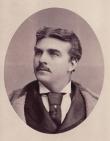Staged with no less than twelve scenes in its three act division, along with the traditional harlequinade and transformation fantasy, and with many of the scenes again subdivided, the production was said to 'bristle with incident' (Sydney Morning Herald 24 December 1894, p.6). Topical allusions, 'atrocious puns' and 'awful political squibs' aimed at prominent local politicians were said to be numerous. Indeed, the Herald's theatre critic records that 'during a casual lapse into plot, one gathers from the dialogue that the house that Jack was to build was a new house for the Legislature of this long-suffering colony. This transpires in fitful flashes in the utterance of heroic metre that permits itself generous license as to scansion; but it is made perfectly plain in the elaborate set piece that is arranged to illustrate the idea' (6).
Musical highlights included the songs 'I Don't Suppose You Have' (sung by Florrie Forde), 'The Charming Slave Ballet;' and 'The Fire Ballet,' with the latter having been devised by George Rignold. Set in the witch's cave, and performed by the Fairy Butterflies, this sensation dance required the dancers to be surrounded by flames, an effect which was claimed had never been tried on any stage in Australia. The Sydney Morning Herald review describes the ballet thus:
Several highly materialised spooks... [dance] a la Macbeth round a cauldron. Presently they set fire to a pile of faggots underneath, and the cauldron is transformed into a sort of shell, wherein rests a beautiful maiden. The flames rise, surround her, and play furiously about her beautiful form, but she preserves a serene smile as one whose conscience is easy and who has a heavy life insurance policy. Then she rises and dances gracefully amid the flames, and soon she is joined by dozens of others (p.6).
Other highlights included 'Christmas in England - Revels in the Snow,' 'The Ascent of the Flying Machine,' and 'The Ogre's Palace of Cards
A number of performers from the 1894 Her Majesty's (Sydney) season were engaged for a tour under the title the Royal Variety and Ballad Company. Jack the Giant Killer's 'Grand Pantomime Harlequinade,' which had been invented and arranged by Will Perman, was staged as a second part extravaganza (with the first part being essentially a minstrel/vaudeville programme. Advertising for the Brisbane Theatre Royal season indicates that the harlequinade was staged in two scenes: Sc 1. 'Regent Street in Humpybong'; Sc 2. 'Any Place You Know Of.'
[Source: Australian Variety Theatre Archive]


